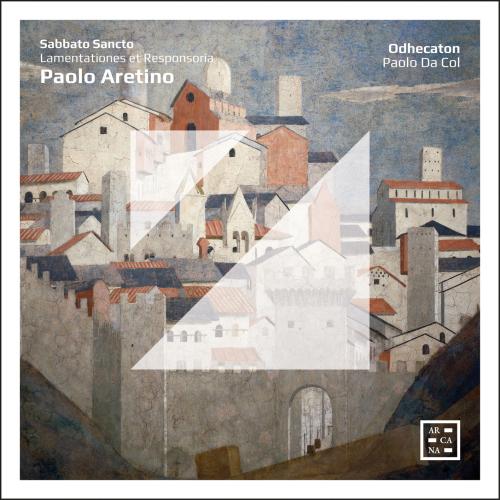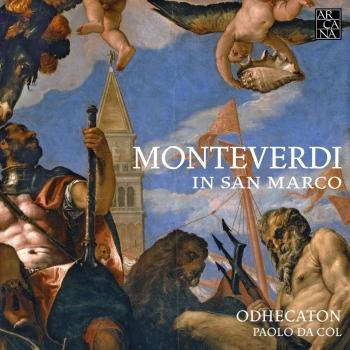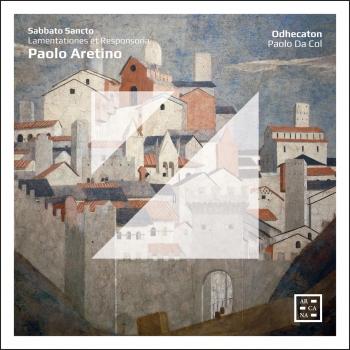
Sabbato Sancto - Paolo Aretino: Lamentationes et Responsoria Odhecaton & Paolo Da Col
Album info
Album-Release:
2023
HRA-Release:
15.09.2023
Label: Arcana
Genre: Classical
Subgenre: Vocal
Artist: Odhecaton & Paolo Da Col
Composer: Paolo Aretino (Paolo Antonio del Bivi (1508-1584)
Album including Album cover Booklet (PDF)
- Paolo Aretino (1508 - 1584): In primo nocturno:
- 1 Aretino: In primo nocturno: Lamentatio I 06:59
- 2 Aretino: In primo nocturno: Responsorium I. Sicut ovis ad occisionem 03:07
- 3 Aretino: In primo nocturno: Lamentatio II 05:55
- 4 Aretino: In primo nocturno: Responsorium II. Jerusalem, luge 02:47
- 5 Aretino: In primo nocturno: Lamentatio III 07:23
- 6 Aretino: In primo nocturno: Responsorium III. Plange quasi virgo 05:00
- In secundo nocturno:
- 7 Aretino: In secundo nocturno: Responsorium IV. Recessit Pastor noster 03:33
- 8 Aretino: In secundo nocturno: Responsorium V. O vos omnes 03:10
- 9 Aretino: In secundo nocturno: Responsorium VI. Ecce quomodo moritur Iustus 04:53
- In tertio nocturno:
- 10 Aretino: In tertio nocturno: Responsorium VII. Astiterunt reges 02:29
- 11 Aretino: In tertio nocturno: Responsorium VIII. Aestimatus sum 02:51
- 12 Aretino: In tertio nocturno: Responsorium IX. Sepulto Domino 05:02
- Benedictus:
- 13 Aretino: Benedictus 09:54
Info for Sabbato Sancto - Paolo Aretino: Lamentationes et Responsoria
Within the Italian polyphonic repertoire for Holy Week of the first half of the 16th century, a group of works that particularly stands out for its organic, comprehensive and unique qualities are the two books of four-voice Lamentations and responsories for the office of Tenebrae from the Triduum sacrum composed by Paolo Aretino (Paolo Antonio del Bivi, 1508-1584). They were published respectively in 1544 (the responsories: a first printed edition of its kind, to the best of our knowledge) and 1549 (the Lamentations). Both books were reprinted in 1563, a rare occurrence for a collection of this type.
Aretino, a maestro di cappella at both the cathedral and Santa Maria della Pieve in Arezzo, was acclaimed in his own day as a true symbol of the city’s glory, along with his fellow-citizen, the famous writer Pietro Aretino. He also had repeated contacts with the Medici court, and indeed certain characteristic features of his style can be traced to the late-15th century Florentine tradition of regularly using polyphony during the Triduum. In particular we note his use of equal voices and, above all, the adoption of an austere and solemn declamatory style closely linked to the structure of the text. All of this, however, is not only conveyed with extreme refinement, but also includes some very striking encroachments into vocal ranges rarely found in contemporary Italian music. An example is the use of two or three bass voices together with a low bass; as happens, for example, in the Lamentations for Holy Saturday, which in this recording are presented complete, together with their respective responsories.
Odhecaton
Paolo Da Col, direction
Odhecaton
The Italian vocal ensemble Odhecaton (pronounced Oh-DE-kah-tohn) owes its name to the first printed book of polyphony, published in 1501 by Ottaviano Petrucci in Venice, Italy: ‘Harmonice Musices Odhecaton’. The word Odhecaton is derived from the Greek words: odè (meaning ‘song’) and ècaton (meaning ‘100’). Harmonice Musices Odhecaton was a collection of some 100 songs.
The name was chosen for the Italian vocal ensemble largely because of its core repertoire, which encompassed the work of French and Flemish composers during the Italian musical renaissance of the 15th century, notably Jacob Obrecht, Josquin Desprez, and Loyset Compère. Since the group’s debut in 1998, the repertoire has grown to include early and contemporary works by a large spectrum of composers.
Directed by Paolo Da Col, Odhecaton brings together some of the best Italian male voices specialized in the performance of Renaissance and baroque music.
The ensemble has made recordings dedicated to the music of Gombert, Isaac, Josquin, Peñalosa and Compère, and has helped rediscover the repertoire of 17th-century Spanish and Portuguese composers active in the Canary Islands. These programmes have led to appearances in Europe's leading festivals, and won them important recognition in the world of recording: 'Diapason d’or de l’année', '5 diapasons','Choc' (Le Monde de la Musique), 'Disco del mese' (Amadeus and CD Classics), and 'Cd of the Year' (Goldberg).
Beyond its central repertoire, Odhecaton has also presented a semi-staged production of Orazio Vecchi’s Amfiparnaso (directed by Enrico Bonavera, with scenery by Lele Luzzatti), and a production of sacred music by Gesualde da Venosa. From 2008 forward, Odhecaton paid particular attention to the music of Palestrina, and recently released a recording of Roland de Lassus. The group also works occasionally with instrumentalists specialized in their repertoire, including Bruce Dickey and Concerto Palatino, Gabriele Cassone, Liuwe Tamminga, Paolo Pandolfo, Jakob Lindberg, La Reverdie, and Andrea De Carlo with Ensemble Mare Nostrum.
Paolo Da Col
completed his musical training at the Conservatorio of Bologna and his musicological studies at the Università Ca’ Foscari of Venice and the Centre d’Études Supérieures de la Renaissance of Tours. From a very early age he has devoted his attention to the Renaissance and preclassical polyphonic repertoire, constantly combining the demands of research and performance.
He has been the director of the journal L’Organo (together with Luigi Ferdinando Tagliavini) and of the music catalogue of the Forni publishing house of Bologna.
He has worked as a music critic, edited publications of instrumental and vocal music, and authored catalogues of musical collections and studies on the history of vocal music. He is presently librarian of the Conservatorio of Venice.
Booklet for Sabbato Sancto - Paolo Aretino: Lamentationes et Responsoria











